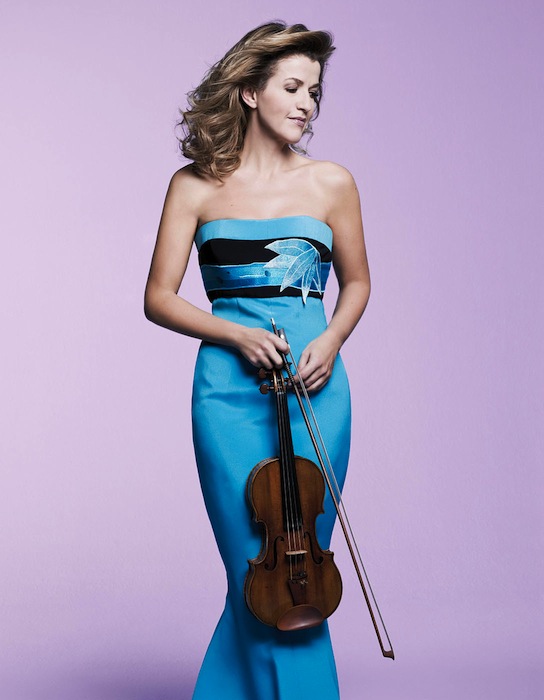Mutter and young colleagues deliver fresh, exhilarating Vivaldi

Anne-Sophie Mutter is, happily, becoming a regular and welcome guest again in Chicago where her appearances were rather fitful for over a decade. The glamorous German violinist is so popular here that many Chicagoans would likely buy tickets to hear her play The Four Seasons with a student ensemble.
In fact, that’s sort of what happened Wednesday night at Symphony Center where Mutter performed Vivaldi’s inescapable seasonally conscious quartet of concertos with the Mutter Virtuosi.
The Mutter Virtuosi is made up of graduates of the Anne-Sophie Mutter Foundation, founded by the violinist in 1997 for the development of young string players from around the world.
Clearly, the foundation is doing something right. The young musicians, who all looked to be in their early 20s, performed with a fire and conviction that matched their starry soloist and benefactor. With Mutter at her finest, this uncommonly fresh and exhilarating performance of The Four Seasons was simply sensational.
Scraping the accumulated grime and detritus from classical music’s Greatest Hit is no mean feat. “Revelatory” might be pushing it, but Wednesday’s brilliant and illuminating Vivaldi performance swept aside all cliches and musty tradition to reveal anew what an original and remarkable composition The Four Seasons is.
Clad in a strapless yellow gown, Mutter caressed the middle movements with her pure, silvery tone, often drawing on a wide dynamic range, as with her elegant, silky cantilena in the slow movement of “Winter.”
It’s sometimes easy to forget what a fearless and combustible solo artist Mutter can be. She ratcheted up the speed and virtuosity with each concerto, the climactic storm of “Summer” a veritable tempest and the final movement of “Winter,” as thrilling an example of blazing fiddle virtuosity as one will ever encounter.
Yet even with Mutter’s solo fireworks there was never a sense of her fronting a deferential backup band. Indeed, the playing of the 13 young string musicians was just as fizzing and electric as that of the soloist. The first cellist was virtually jamming with Mutter in their tandem moments and all the players brought an array of coloring and unique sonics, as with the the strange and mysterious opening to the middle movement of “Autumn.” Veteran harpsichordist Knut Johannessen provided discreet yet superbly musical support.
Mutter forsook her formal gown for casual-chic black pants and jacket to join seven of her young colleagues in Mendelssohn’s Octet.
Tackling the flashy first-violin part, Mutter played more as an ensemble member than first-among-equals soloist. Yet in the Octet–another extraordinarily mature work from the teenage Mendelssohn—the playing of the young musicians felt more cautious than in the Vivaldi concertos. There was little “fuoco” in the polite rendering of the opening movement, apart from the two cellists who leaned into the music in a way that made their colleagues seem inhibited. The legacy of Orchestra Hall’s 1997 renovation, with its bleaching of upper frequencies, may have been partly to blame for the unfocused projection of violins and viola.
The Andante fared better, rendered with delicacy in a galant style, and the Scherzo was fleet and lightly articulated. The musicians threw off caution in the final Presto, playing with greater elan and bravura.
The evening opened in grittier fashion with Sebastian Currier’s Ring Tones.
Among our most gifted composers, Currier wrote his Time Machines—one of the finest violin concertos of recent decades—for Mutter. Other notable recent works including Sleepers and Dreamers, premiered at the Grant Park Music Festival in 2012.
Also written for Mutter, the title of Ring Tones and opening cell-ring theme seem like a wry comment on clueless audience members who leave their phones on. Written for violin and double-bass, the two instruments mine a wide range of astringent material from the ring motif, with the emphasis on harmonics and partials, often evoking Baroque models in a quasi-passacaglia form.
Currier’s substantial working out is typically smart and individual, with much contrast in the conversational back and forth. Mutter’s refined, luminous tone is highlighted in the soaring lines and high lines and bassist Roman Patkolo was a fully committed and equally virtuosic partner with Mutter.
The extended ovations after the Vivaldi brought Mutter back out for a tour de force encore of the “Summer” storm movement from The Four Seasons and a glowing, benedictory rendering of the Air from Bach’s Orchestral Suite No. 3.
Posted in Performances


